15个英语最常见的介词用法
常见的英语介词及其用法
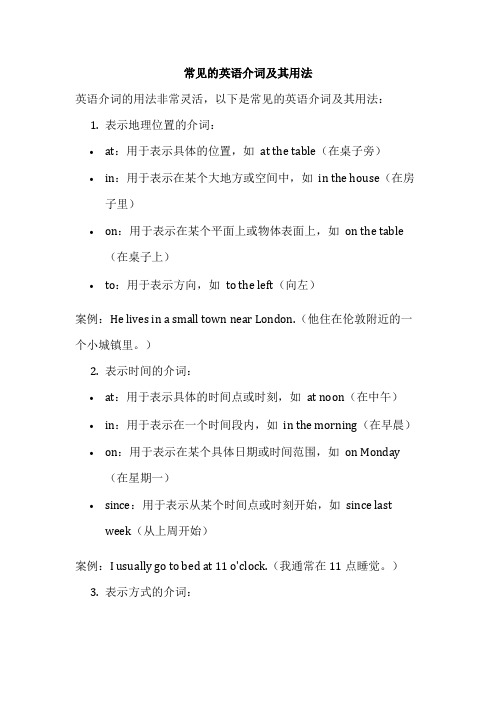
常见的英语介词及其用法英语介词的用法非常灵活,以下是常见的英语介词及其用法:1.表示地理位置的介词:•at:用于表示具体的位置,如at the table(在桌子旁)•in:用于表示在某个大地方或空间中,如in the house(在房子里)•on:用于表示在某个平面上或物体表面上,如on the table (在桌子上)•to:用于表示方向,如to the left(向左)案例:He lives in a small town near London.(他住在伦敦附近的一个小城镇里。
)2.表示时间的介词:•at:用于表示具体的时间点或时刻,如at noon(在中午)•in:用于表示在一个时间段内,如in the morning(在早晨)•on:用于表示在某个具体日期或时间范围,如on Monday (在星期一)•since:用于表示从某个时间点或时刻开始,如since last week(从上周开始)案例:I usually go to bed at 11 o'clock.(我通常在11点睡觉。
)3.表示方式的介词:•by:用于表示通过某种方式或交通工具,如by bus(乘公共汽车)•with:用于表示使用某种工具或方法,如with a knife(用刀子)•in:用于表示使用某种语言或穿着某种衣服,如in English (用英语)•on:用于表示在某种媒介上,如on TV(在电视上)案例:We usually communicate with each other by email.(我们通常通过电子邮件彼此沟通。
)4.表示原因的介词:•for:用于表示为了某个目的或原因,如for help(为了寻求帮助)•from:用于表示由于某个来源或原因,如from fear(由于恐惧)•about:用于表示关于某个话题或事件,如about the weather (关于天气)案例:She is studying for the exam.(她正在为考试而学习。
15个英语最常见的介词用法-极简英语

15个英语最常见介词(in on at of for...)的深层次含义英文中15个最常见的介词in/ on/at/of/ for/by /with/ from/to/as/ about/ around/ off/ through/ over一、in (在..里面)1.表示真实的位置: in the car/room2表示抽象的位置: in the book/movie3.表示状态: in danger, in trouble; in anger3.表示时间: in the morning/afternoon/evening. in April; in 20104.表示方式: in the way; in English5.表示穿着: in black shoes/T-shirt二、on (紧紧地接触-连着)1.表示真实的位置: on the table/wall2.表示抽象的位置: on the radio/TV; on the topic/event3.表示具体的时间: on Monday; on Monday morning; on May 4th4.表示状态: on duty; on holiday; the game is on三、at(在.点上)1.表示真实的位置: at home/the company/the store2.表示抽象的位置: be good/bad at English3.表示具体的时间: at 3 pm;at night; at the age of 204.表示状态: at work-在工作; at table-在吃饭四、Of(的-从属关系)1.表示"无生命主体的":the window of the room; top of the mountain...2.某某市: the city of Bejing3.表示数量: a piece/bx/bottle/pair.. of五、for(为了/因为/对时间/对.而言/支持赞成)1.表示为了":go for a walk; I come here fr my schoolbag2.表示"因为": Thank you for helping me; for the reason3.表示"时间"和: for 3 days; for a week; for a year4.表示对..而言": It is important for me5.表示”支持,赞成": Are you for this plan or against it?六、by(通过.交通工具/在.附近/街至.时间/被)1.表示"通过.交通工具":by train/subway/plane/air/ship/seaI learn English by watchingEnglish movies.2.表示在附近":a table by the window; the house is by the lake3.表示"截至到..时间":by the end of next week; by 20194.表示"被(被动语态)":English is spoken by people all over the world.七、with (伴随)1.表示"和.起":go with:play with;make friends with;cooperate with2.表示"携有,带有":a county with a long history; a house with a big garden3.表示..工具:cut the apple with the knife4.表示"伴随":with the development of the society;with the help of my teacher;I don't have any cash with me.八、from (远离)1.表示"来自":I am/come from China;a gift from my best friend;a man from America2.由"远离"来记短语:stop/prevent/keep sb from doing sth阻止某人做某事be away from...远离...be different from与.不同be absent from缺席....how far is it from here?它离这远The paper is made from wood.这纸是由木头制成的3.表示..到": from...to...由"指向"来理解下列用法:The road leads to Paris.这条路通往巴黎Smoking is harmful to your health.吸烟有害健康the answer to the question.这个问题的答案九、to (指向..)contribute to对..做贡献on one's way to... 在某人去某地的路上belong to属于..be used to doing sth习惯于做某事lead to...导致十、as作为He works as a tour guide.他作为导游工作。
英语介词用法详解

英语介词用法详解英语介词是连接词与词之间关系的重要语法成分,它们用于表示空间、时间、关系等概念。
正确的使用介词是英语学习的基础之一。
本文将详细介绍英语介词的常见用法。
一、表示方向和位置的介词1. In(在):用于大的地点范围之内,表示“在……里面”。
- There is a book on the desk.- I live in New York.2. On(在、在上、在……上面):用于平面、表面或边界之上。
- The cat is on the table.- The painting hangs on the wall.3. At(在、在……附近):用于特定的地点或位置。
- I met him at the park.- We will meet at the restaurant.4. Under(在……下面):表示相对高度或遮挡。
- The cat is under the table.- He found his keys under the sofa.5. Behind(在……后面):表示在某物后面。
- The car is parked behind the house.- She is hiding behind the tree.6. Beside(在……旁边):表示在某物的旁边。
- My house is beside the park.- She sat beside her friends.7. Inside(在……里面):表示在某物的内部。
- The wallet is inside the bag.- There is a surprise inside the box.8. Outside(在……外面):表示在某物的外部。
- The children are playing outside the house.- Don't forget to lock the door when you go outside.二、表示时间的介词1. On(在某天):用于特定的日期。
英语常见介词整理
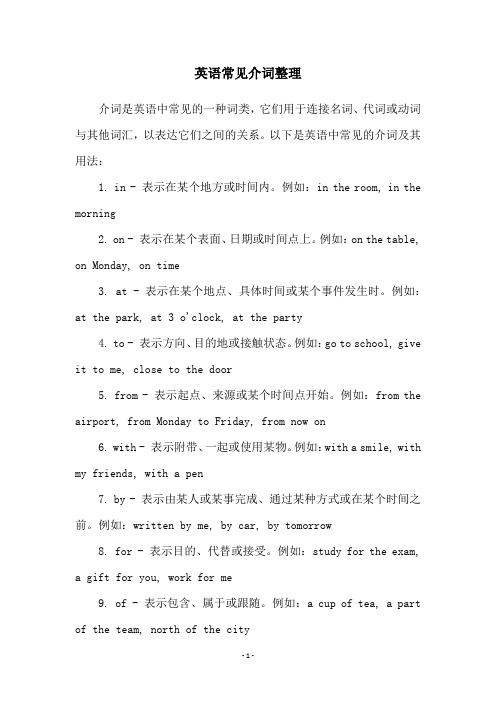
英语常见介词整理介词是英语中常见的一种词类,它们用于连接名词、代词或动词与其他词汇,以表达它们之间的关系。
以下是英语中常见的介词及其用法:1. in - 表示在某个地方或时间内。
例如:in the room, in the morning2. on - 表示在某个表面、日期或时间点上。
例如:on the table, on Monday, on time3. at - 表示在某个地点、具体时间或某个事件发生时。
例如:at the park, at 3 o'clock, at the party4. to - 表示方向、目的地或接触状态。
例如:go to school, give it to me, close to the door5. from - 表示起点、来源或某个时间点开始。
例如:from the airport, from Monday to Friday, from now on6. with - 表示附带、一起或使用某物。
例如:with a smile, with my friends, with a pen7. by - 表示由某人或某事完成、通过某种方式或在某个时间之前。
例如:written by me, by car, by tomorrow8. for - 表示目的、代替或接受。
例如:study for the exam,a gift for you, work for me9. of - 表示包含、属于或跟随。
例如:a cup of tea, a part of the team, north of the city10. about - 表示关于、大约或围绕。
例如:talk about the weather, about 2 hours, walk about the park以上是英语中常见的介词及其用法,掌握它们的使用方法可以帮助我们更好地理解和使用英语。
英语介词用法详解

英语介词是连接名词、代词或名词短语与其他词语的词,它们在句中不能单独作句子成分,需要与它们的宾语一起构成介词短语。
介词的用法多种多样,以下是一些常见英语介词的用法详解:1. 时间介词:- at:表示在某一具体时刻,如“At 6 o'clock”。
- on:表示在具体的某一天或某一天的上午、下午、晚上,如“On Monday”或“On the morning of July 4th”。
- in:表示在一段时间内,如“In the summer”或“In the 20th century”。
- by:表示在某一时间之前,如“By 5 o'clock”。
- before:表示在某一时间之前,如“Before lunch”。
- after:表示在某一时间之后,如“After the meeting”。
- since:表示自从某一时间以来,如“Since last month”。
- until/till:表示直到某一时间为止,如“Until 9 o'clock”或“Till the end of the day”。
2. 地点介词:- at:表示在某一地点,如“At the library”。
- in:表示在某一地区、城市或国家,如“In New York”或“In France”。
- on:表示在某一平面或表面,如“On the table”或“On the floor”。
- above:表示在某一地点的上方,如“Above the clouds”。
- below:表示在某一地点的下方,如“Below the bridge”。
- near:表示靠近某一地点,如“Near the river”。
- between:表示在两者之间,如“Between the trees”。
- beyond:表示超过某一地点,如“Beyond the horizon”。
3. 方式介词:- by:表示通过某种方式或手段,如“By car”或“By phone”。
英语介词用法汇总

英语介词用法汇总一、表示时间的常用介词1.英语介词at,in与onat表示时间的一点;in表示一个时期;on表示特殊日子。
如:He goes to school at seven o’clock in the morning. 他早晨七点上学。
Can you finish the work in two days. 你能在两天内完成这个工作吗?Linda was born on the second of May. 琳达五月二日出生。
①at后常接具体的时间点,如黎明,中午,日出,日落,开始等。
如:at five o’clock (五点),at down (黎明),at daybreak (天亮),at sunrise (日出),at noon (中午),at sunset (日落),at midnight (半夜),at the beginning of the month (月初),at that time (那时),at that moment (那会儿),at this time of day (在一天的这个时候)。
②in后常接时间段,如年,月,白天,季节,世纪,泛指的上午,下午,晚上等。
如:in 2006(2006年),in May,2004 (2004年五月),in the morning (早晨/上午),in the afternoon (下午),in the evening (晚上),in the night (夜晚),in the daytime (白天),in the 21st century (21世纪),in three days (weeks/month)三天(周/个月),in a week (一周),in spring (春季)。
③on后常接某日,星期几,某日或某周日的朝夕,节日,及有修饰语修饰的下午、晚上等。
如:on Sunday (星期日),on a warm morning in April (四月的一个温暖的上午),on a December night (12月的一个夜晚),on that afternoon (那天下午),on the following night (下一个晚上),on Christmas afternoon (圣诞节下午),on October 1,1949 (1949年10月1日),on New Year’s Day (新年),on New Year’s Eve (除夕),on the morning of the 15th (15日的早上)等。
英语常用介词以及用法
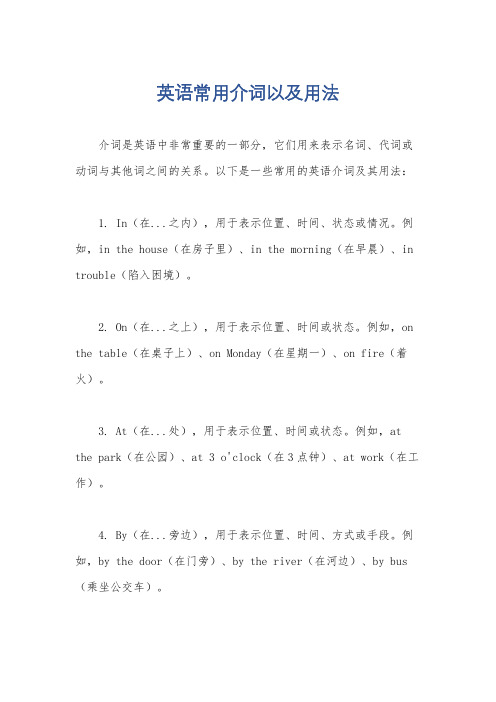
英语常用介词以及用法介词是英语中非常重要的一部分,它们用来表示名词、代词或动词与其他词之间的关系。
以下是一些常用的英语介词及其用法:1. In(在...之内),用于表示位置、时间、状态或情况。
例如,in the house(在房子里)、in the morning(在早晨)、in trouble(陷入困境)。
2. On(在...之上),用于表示位置、时间或状态。
例如,on the table(在桌子上)、on Monday(在星期一)、on fire(着火)。
3. At(在...处),用于表示位置、时间或状态。
例如,at the park(在公园)、at 3 o'clock(在3点钟)、at work(在工作)。
4. By(在...旁边),用于表示位置、时间、方式或手段。
例如,by the door(在门旁)、by the river(在河边)、by bus (乘坐公交车)。
5. For(为了),用于表示目的、受益者或时间。
例如,for you(为你)、for two hours(两个小时)、for fun(为了好玩)。
6. With(和...一起),用于表示伴随、方式或工具。
例如,with my friends(和我的朋友们一起)、with care(小心地)、with a knife(用刀)。
7. From(从...处),用于表示起点、来源或时间。
例如,from the store(从商店)、from China(来自中国)、from Monday to Friday(从周一到周五)。
这些介词只是英语中的一部分,但它们是最常用的。
它们的正确使用对于表达清晰、准确的意思至关重要。
希望这些例子可以帮助你更好地理解英语介词的用法。
15个英语最常见的介词用法-极简英语

15个英语最常见介词(in on at of for...)的深层次含义英文中15个最常见的介词in/ on/at/of/ for/by /with/ from/to/as/ about/ around/ off/ through/ over一、in (在..里面)1.表示真实的位置: in the car/room2表示抽象的位置: in the book/movie3.表示状态: in danger, in trouble; in anger3.表示时间: in the morning/afternoon/evening. in April; in 20104.表示方式: in the way; in English5.表示穿着: in black shoes/T-shirt二、on (紧紧地接触-连着)1.表示真实的位置: on the table/wall2.表示抽象的位置: on the radio/TV; on the topic/event3.表示具体的时间: on Monday; on Monday morning; on May 4th4.表示状态: on duty; on holiday; the game is on三、at(在.点上)1.表示真实的位置: at home/the company/the store2.表示抽象的位置: be good/bad at English3.表示具体的时间: at 3 pm;at night; at the age of 204.表示状态: at work-在工作; at table-在吃饭四、Of(的-从属关系)1.表示"无生命主体的":the window of the room; top of the mountain...2.某某市: the city of Bejing3.表示数量: a piece/bx/bottle/pair.. of五、for(为了/因为/对时间/对.而言/支持赞成)1.表示为了":go for a walk; I come here fr my schoolbag2.表示"因为": Thank you for helping me; for the reason3.表示"时间"和: for 3 days; for a week; for a year4.表示对..而言": It is important for me5.表示”支持,赞成": Are you for this plan or against it?六、by(通过.交通工具/在.附近/街至.时间/被)1.表示"通过.交通工具":by train/subway/plane/air/ship/seaI learn English by watchingEnglish movies.2.表示在附近":a table by the window; the house is by the lake3.表示"截至到..时间":by the end of next week; by 20194.表示"被(被动语态)":English is spoken by people all over the world.七、with (伴随)1.表示"和.起":go with:play with;make friends with;cooperate with2.表示"携有,带有":a county with a long history; a house with a big garden3.表示..工具:cut the apple with the knife4.表示"伴随":with the development of the society;with the help of my teacher;I don't have any cash with me.八、from (远离)1.表示"来自":I am/come from China;a gift from my best friend;a man from America2.由"远离"来记短语:stop/prevent/keep sb from doing sth阻止某人做某事be away from...远离...be different from与.不同be absent from缺席....how far is it from here?它离这远The paper is made from wood.这纸是由木头制成的3.表示..到": from...to...由"指向"来理解下列用法:The road leads to Paris.这条路通往巴黎Smoking is harmful to your health.吸烟有害健康the answer to the question.这个问题的答案九、to (指向..)contribute to对..做贡献on one's way to... 在某人去某地的路上belong to属于..be used to doing sth习惯于做某事lead to...导致十、as作为He works as a tour guide.他作为导游工作。
英语介词的用法归纳
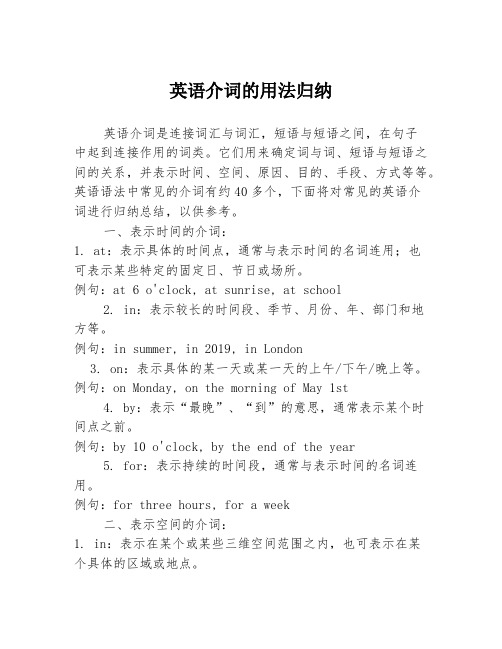
英语介词的用法归纳英语介词是连接词汇与词汇,短语与短语之间,在句子中起到连接作用的词类。
它们用来确定词与词、短语与短语之间的关系,并表示时间、空间、原因、目的、手段、方式等等。
英语语法中常见的介词有约40多个,下面将对常见的英语介词进行归纳总结,以供参考。
一、表示时间的介词:1. at:表示具体的时间点,通常与表示时间的名词连用;也可表示某些特定的固定日、节日或场所。
例句:at 6 o'clock, at sunrise, at school2. in:表示较长的时间段、季节、月份、年、部门和地方等。
例句:in summer, in 2019, in London3. on:表示具体的某一天或某一天的上午/下午/晚上等。
例句:on Monday, on the morning of May 1st4. by:表示“最晚”、“到”的意思,通常表示某个时间点之前。
例句:by 10 o'clock, by the end of the year5. for:表示持续的时间段,通常与表示时间的名词连用。
例句:for three hours, for a week二、表示空间的介词:1. in:表示在某个或某些三维空间范围之内,也可表示在某个具体的区域或地点。
例句:in the room, in the park2. on:表示在某个平面面上,通常用来表示地点。
例句:on the table, on the wall3. at:表示在某个具体的地点或位置。
例句:at the door, at the bus stop4. by:表示“靠近”、“经过”等含义。
例句:by the river, by the window5. between:表示在两个或两个以上的物体或位置之间。
例句:between two mountains, between the buildings6. among:表示在三个或三个以上的物体或位置之间。
英语中常见介词用法总结

英语中常见介词用法总结三、At1.动词+ at。
at表示“指向某一目标,到达某地”:arrive at抵达,call at访问某地, catch at(it)当场抓住, come at攻击, fire at向…开火,glance at瞟一眼, glare at怒目而视, grieve at忧伤,knock at敲, laugh at嘲笑, look at看一眼, pull at拉扯, rejoice at对…高兴,smile at向某人微笑, shoot at朝…射击, stare at怒目而视,thrust at刺向, tear at撕, tremble at颤抖,wonder at吃惊,work at工作。
例如:Don’t let me catch you again at it.不要再让我当场逮住你。
We must “shoot the arrow at the target”. 我们必须有的放矢。
They trembled at the sight of the peasant’s spears.看到农民的梭标,他们阵阵发抖。
2. be +形容词/过去分词+ at。
其中at表示“情绪、情感的原因,或对某物具有某种感情”:be angry at恼怒于, be alarmed at对…保持警觉,be astonished at对…吃惊, be bad at不擅长, be clever at对某事很灵巧,be delighted at高兴,be disgusted at厌恶, be disappointed at对…失望,be good at擅长, be i mpatient at对…不够耐心, be mad at狂热于,be pleased at对…感到高兴, be present at出席, be satis fied at满意,be surprised at吃惊, be shocked at对…非常震惊,be terrified at受到…的恐吓,be quic k at对…很机敏。
英语中常见介词用法
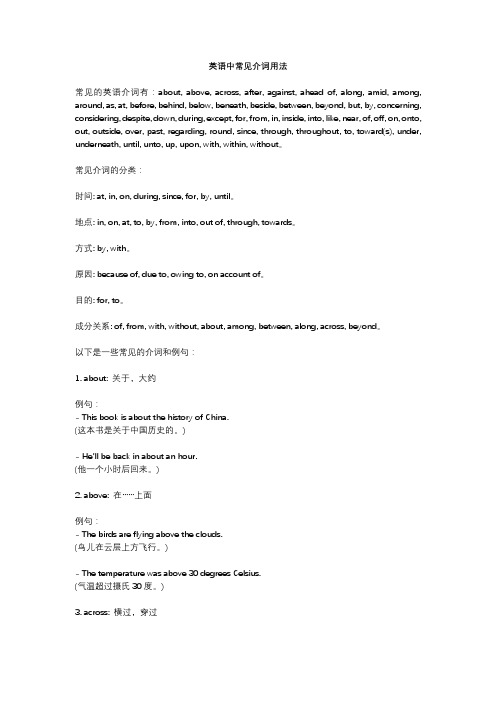
英语中常见介词用法常见的英语介词有:about, above, across, after, against, ahead of, along, amid, among, around, as, at, before, behind, below, beneath, beside, between, beyond, but, by, concerning, considering, despite, down, during, except, for, from, in, inside, into, like, near, of, off, on, onto, out, outside, over, past, regarding, round, since, through, throughout, to, toward(s), under, underneath, until, unto, up, upon, with, within, without。
常见介词的分类:时间: at, in, on, during, since, for, by, until。
地点: in, on, at, to, by, from, into, out of, through, towards。
方式: by, with。
原因: because of, due to, owing to, on account of。
目的: for, to。
成分关系: of, from, with, without, about, among, between, along, across, beyond。
以下是一些常见的介词和例句:1. about: 关于,大约例句:- This book is about the history of China.(这本书是关于中国历史的。
)- He'll be back in about an hour.(他一个小时后回来。
英语常用介词以及用法

英语常用介词以及用法全文共四篇示例,供读者参考第一篇示例:英语中的介词是一类常见的词性,它通常用来在句子中引起名词、代词、动词等成分之间的关系。
这些关系主要包括位置、方向、时间、原因、方式等。
介词在英语中扮演着非常重要的角色,掌握常用介词以及它们的用法对于提升写作和口语能力至关重要。
下面将介绍一些常用的英语介词以及它们的用法。
1. In"In" 是一个非常常用的介词,它通常表示某物在某个位置或状态中。
比如:- I am in the kitchen.(我在厨房)- She is in a meeting.(她在开会)- The cat is in the box.(猫在盒子里)"in" 也可以表示时间的概念:- The meeting is in the afternoon.(会议在下午)2. On- We will have a party on Christmas Day.(我们将在圣诞节那天举办派对)3. At"At" 用于表示某物在某个具体的地点或时间。
比如:"At" 还可以表示某种状态或情况:4. By"By" 可以表示近旁、附近,或通过某种方式。
比如:- The park is by the river.(这个公园在河边)- She goes to work by bus.(她乘公交车上班)5. With"With" 表示陪伴、一起,也可以表示使用某种工具或手段。
比如:- He is happy with his new job.(他对他的新工作感到高兴)6. For"For" 通常表示目的、原因、利益。
比如:- I bought a gift for my sister.(我给我妹妹买了份礼物)- He is studying for the exam.(他正在为考试而学习)"From" 表示从某处出发或起源。
英语中常用介词的基本用法
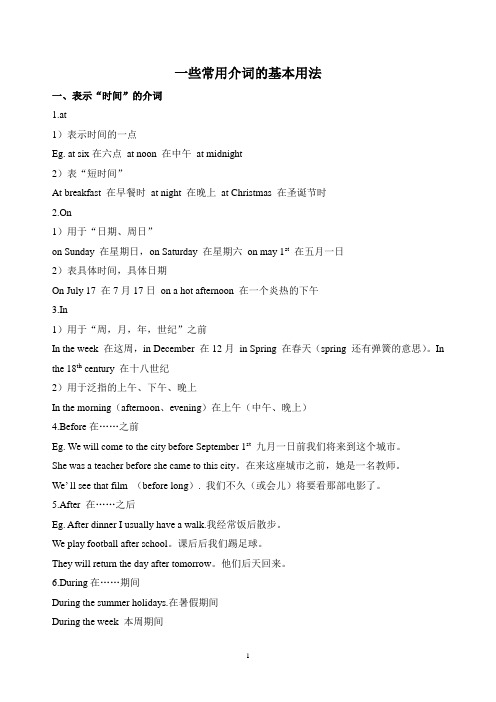
一些常用介词的基本用法一、表示“时间”的介词1.at1)表示时间的一点Eg. at six在六点at noon 在中午at midnight2)表“短时间”At breakfast 在早餐时at night 在晚上at Christmas 在圣诞节时2.On1)用于“日期、周日”on Sunday 在星期日,on Saturday 在星期六on may 1st在五月一日2)表具体时间,具体日期On July 17 在7月17日on a hot afternoon 在一个炎热的下午3.In1)用于“周,月,年,世纪”之前In the week 在这周,in December 在12月in Spring 在春天(spring 还有弹簧的意思)。
In the 18th century 在十八世纪2)用于泛指的上午、下午、晚上In the morning(afternoon、evening)在上午(中午、晚上)4.Before在……之前Eg. We will come to the city before September 1st九月一日前我们将来到这个城市。
She was a teacher before she came to this city。
在来这座城市之前,她是一名教师。
We’ ll see that film (before long). 我们不久(或会儿)将要看那部电影了。
5.After 在……之后Eg. After dinner I usually have a walk.我经常饭后散步。
We play football after school。
课后后我们踢足球。
They will return the day after tomorrow。
他们后天回来。
6.During在……期间During the summer holidays.在暑假期间During the week 本周期间During the last few years在最近几年。
英语介词用法最全总结
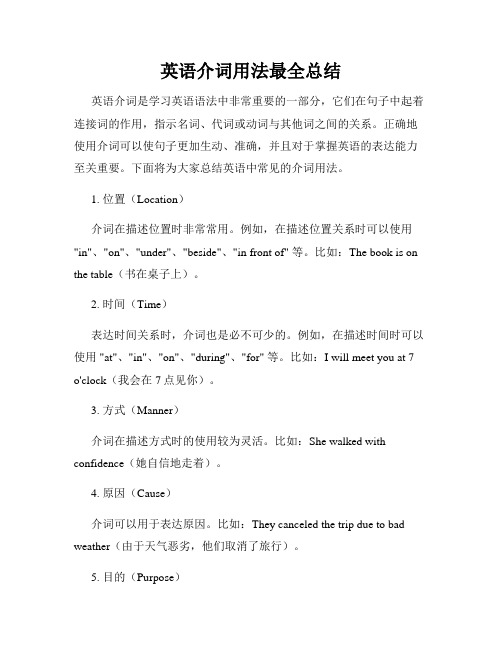
英语介词用法最全总结英语介词是学习英语语法中非常重要的一部分,它们在句子中起着连接词的作用,指示名词、代词或动词与其他词之间的关系。
正确地使用介词可以使句子更加生动、准确,并且对于掌握英语的表达能力至关重要。
下面将为大家总结英语中常见的介词用法。
1. 位置(Location)介词在描述位置时非常常用。
例如,在描述位置关系时可以使用"in"、"on"、"under"、"beside"、"in front of" 等。
比如:The book is on the table(书在桌子上)。
2. 时间(Time)表达时间关系时,介词也是必不可少的。
例如,在描述时间时可以使用 "at"、"in"、"on"、"during"、"for" 等。
比如:I will meet you at 7 o'clock(我会在7点见你)。
3. 方式(Manner)介词在描述方式时的使用较为灵活。
比如:She walked with confidence(她自信地走着)。
4. 原因(Cause)介词可以用于表达原因。
比如:They canceled the trip due to bad weather(由于天气恶劣,他们取消了旅行)。
5. 目的(Purpose)介词也能表达目的。
比如:He went to the store to buy some groceries (他去商店买些食品)。
6. 所属关系(Possession)介词可以用于表达所属关系。
比如:This book belongs to me(这本书是我的)。
7. 比较(Comparison)在进行比较时,介词也可以派上用场。
比如:I am taller than my sister(我比我妹妹高)。
英语介词的用法
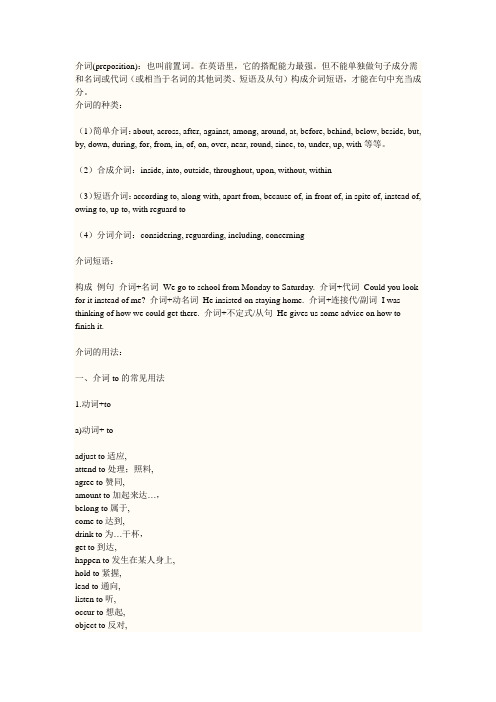
介词(preposition):也叫前置词。
在英语里,它的搭配能力最强。
但不能单独做句子成分需和名词或代词(或相当于名词的其他词类、短语及从句)构成介词短语,才能在句中充当成分。
介词的种类:(1)简单介词:about, across, after, against, among, around, at, before, behind, below, beside, but, by, down, during, for, from, in, of, on, over, near, round, since, to, under, up, with等等。
(2)合成介词:inside, into, outside, throughout, upon, without, within(3)短语介词:according to, along with, apart from, because of, in front of, in spite of, instead of, owing to, up to, with reguard to(4)分词介词:considering, reguarding, including, concerning介词短语:构成例句介词+名词We go to school from Monday to Saturday. 介词+代词Could you look for it instead of me? 介词+动名词He insisted on staying home. 介词+连接代/副词I was thinking of how we could get there. 介词+不定式/从句He gives us some advice on how to finish it.介词的用法:一、介词to的常见用法1.动词+toa)动词+ toadjust to适应,attend to处理;照料,agree to赞同,amount to加起来达…,belong to属于,come to达到,drink to为…干杯,get to到达,happen to发生在某人身上,hold to紧握,lead to通向,listen to听,occur to想起,object to反对,point to指向,respond to回答,refer to参考;指的是…;涉及,reply to回答,see to负责,stick to坚持,turn to求助,write to给某人写信。
英语介词的用法归纳
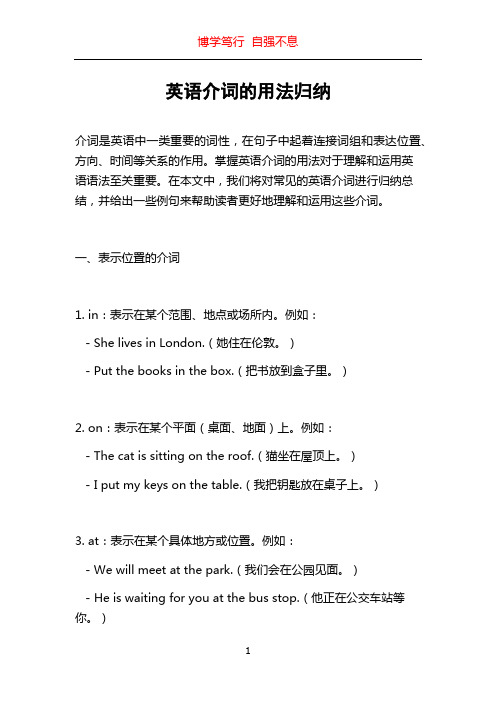
英语介词的用法归纳介词是英语中一类重要的词性,在句子中起着连接词组和表达位置、方向、时间等关系的作用。
掌握英语介词的用法对于理解和运用英语语法至关重要。
在本文中,我们将对常见的英语介词进行归纳总结,并给出一些例句来帮助读者更好地理解和运用这些介词。
一、表示位置的介词1. in:表示在某个范围、地点或场所内。
例如:- She lives in London.(她住在伦敦。
)- Put the books in the box.(把书放到盒子里。
)2. on:表示在某个平面(桌面、地面)上。
例如:- The cat is sitting on the roof.(猫坐在屋顶上。
)- I put my keys on the table.(我把钥匙放在桌子上。
)3. at:表示在某个具体地方或位置。
例如:- We will meet at the park.(我们会在公园见面。
)- He is waiting for you at the bus stop.(他正在公交车站等你。
)二、表示方向的介词1. to:表示动作的方向。
例如:- I went to the supermarket.(我去了超市。
)- She walked to the park.(她走到了公园。
)2. into:表示进入某个地方或物体内部。
例如:- The cat jumped into the box.(猫跳进了盒子里。
)- He put the book into his bag.(他把书放进了书包里。
)3. out of:表示离开某个地方或物体外部。
例如:- She ran out of the room.(她从房间里跑了出来。
)- Take the dishes out of the dishwasher.(把盘子从洗碗机里取出来。
)三、表示时间的介词1. at:表示具体的时间点。
例如:- The party starts at 7 p.m.(晚会从晚上7点开始。
英语常用介词及用法
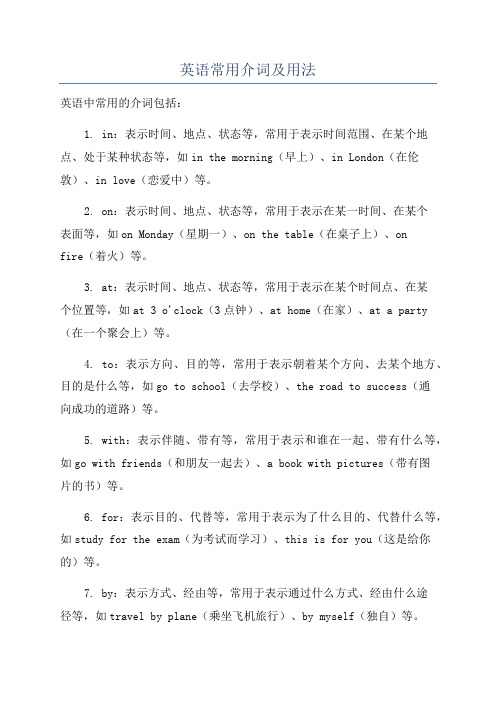
英语常用介词及用法英语中常用的介词包括:1. in:表示时间、地点、状态等,常用于表示时间范围、在某个地点、处于某种状态等,如in the morning(早上)、in London(在伦敦)、in love(恋爱中)等。
2. on:表示时间、地点、状态等,常用于表示在某一时间、在某个表面等,如on Monday(星期一)、on the table(在桌子上)、onfire(着火)等。
3. at:表示时间、地点、状态等,常用于表示在某个时间点、在某个位置等,如at 3 o'clock(3点钟)、at home(在家)、at a party (在一个聚会上)等。
4. to:表示方向、目的等,常用于表示朝着某个方向、去某个地方、目的是什么等,如go to school(去学校)、the road to success(通向成功的道路)等。
5. with:表示伴随、带有等,常用于表示和谁在一起、带有什么等,如go with friends(和朋友一起去)、a book with pictures(带有图片的书)等。
6. for:表示目的、代替等,常用于表示为了什么目的、代替什么等,如study for the exam(为考试而学习)、this is for you(这是给你的)等。
7. by:表示方式、经由等,常用于表示通过什么方式、经由什么途径等,如travel by plane(乘坐飞机旅行)、by myself(独自)等。
8. of:表示所属、材料等,常用于表示属于什么、由什么材料等,如the book of John(约翰的书)、a cup of tea(一杯茶)等。
10. with:表示附带条件或伴随状况,常用于表述某些含义,如join with sb. to do sth.(和某人一起做某事)、in line with sth.(与某事意见相符)等。
这些介词的用法比较广泛,需要根据具体语境进行使用。
英语介词的用法

4. in the day time在白天
5. in 2002 (2002可读作two thousand two)在2002年
6. He's to quit in May. (in May)他在五月就辞职了。
11. in the newspaper在报上
12. in the sky在空中
13. in the bed在床上(也可用on the bed)
14. in the bedroom/ class/ library/ school在寝室/课室/图书馆/学校
(3). on把地方、地点、位置当作一个平面:
姐姐住在一个小市镇。(如果把city看做一个圆圈,small town就成一个点。因此就in
a city, at a small town.呵呵)
4. We have a meeting in Beijing.我们有北京有一个会议。
5. Mars is in the Solar System.火星在太阳系里。
5. The train is due at 12.15 p.m. (at 12.15p.m.)
那班火车的到站时间是12点15分。
6. at mid-autumn festival/ at Christmas / at Spring Festival
在中秋节/在圣诞节/在春节
7. at forty在四十岁时
司/学校
(2).in把地方、地点、位置当作一个范围或一个封闭的空间:
1. I live in London.我住在伦敦。(大城市用in)
2. I live in England, at London.我住在英国伦敦。(England大过London喔)
